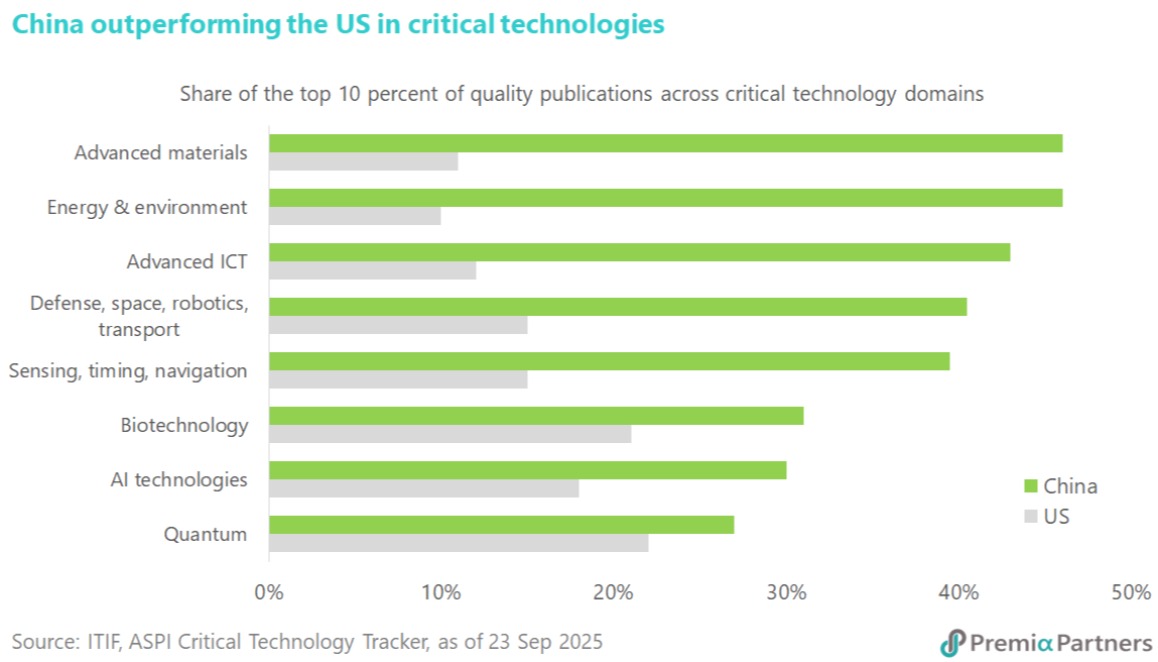
精選觀點 & Webinar
Surging Treasury yields and increasing anxiety over the Fed’s ‘higher for longer’ policy led global equities to ‘risk-off’ in the third quarter, though the challenge for Chinese stocks in the CSI 300 Index, down -2.9% for the quarter, remained mostly a function of negative sentiment toward China’s property market and skepticism that policymakers were doing enough to put the nation’s economic recovery back on track. Nevertheless, we saw some very positive signs in Q3, with Beijing beginning to implement targeted stimulus that, by quarter end, already appears to be bearing fruit. From a factor perspective, the new economy portfolio’s quality growth exposure is effectively levered to the upside surprises we see as significantly undervalued at this moment, while the bedrock index should continue to benefit from value and quality exposures, allowing us to identify true bargains poised for revaluation. In this article, Dr. Phillip Wool, Global Head of Research of Rayliant Global Advisors, discusses third-quarter performance and outline our expectations for China’s economy and market as 2023 draws to a close.
Nov 06, 2023
Bloomberg reported that Chinese policymakers, led by the Ministry of Finance and the National Development and Reform Commission, are planning to launch a new round of stimulus, involving a potential issuance of at least RMB 1 trillion of additional China government bonds and an upward revision of fiscal budget deficit. Some investors may be worried about its negative impact on the bond market with the potential jump in supply. In this article, our Partner & Co-CIO David Lai discusses why we agree with most analysts that it would not create any lasting impact even if the plan materializes. In fact, China remains disciplined in fiscal policy whilst the overall monetary stance stays accommodative. China government bonds have outperformed almost all other sovereign bonds this year due to the rate cuts and low inflation expectations. The long end of China yield curve in particular benefited the most year-to-date, with the yields on 10-year, 30-year, and 50-year having fallen 13.8bps, 18.0bps, and 20.2bps respectively already.
Oct 19, 2023
From “Goldilocks” to “Nightmare on Wall Street” – the convergence of structural and cyclical forces looks set to inflict a lot more damage on US assets. For some time now, we had been warning about the upside risks to US Treasury yields. That slow, upward creep in US Treasury yields recently turned into a rampage, with nasty implications for both US bonds and equities. Meanwhile structural factors are further feeding the rise in UST yields – more supply, less demand. In this article, our Senior Advisor Say Boon Lim discusses about the great refinancing pressure of US government debt looming, how a lot of stuff could “break” if funding costs keep going up – including US banks – and how things may play out if the structural factors are dominant, a cyclical economic downturn may not necessarily bring down funding costs.
Oct 19, 2023
China has emerged as the world’s largest consumer and producer for industrial robots and equipment. In fact, the country recorded US$6.6 billion sales of industrial robotics in 2022, most of which were produced domestically, far more than the second largest country Germany which registered US$2 billion sales during the same year. Propelled by its changing demographics and its evolution from low-cost manufacturing to high-value added processes, China will continue to drive the development of a homegrown robotics sector and pursue manufacturing upgrade, as underscored by China’s 14th Five Year Plan which explicitly laid out the national strategic goal of building a modern high tech society. Sector leaders would be natural beneficiaries of support measures for this broad policy. In this article we discuss more about how along with development of a highly integrated ecosystem of high tech processes and smart manufacturing systems, China is also integrating new materials, new energy, smart grids and energy saving systems, etc. to its technology-enabled ecosystem that sits well with China’s 2060 net zero targets, and its national strategic goal towards a modern, high tech society.
Sep 29, 2023
The youth unemployment rate in China has been much talked about, however the phenomenon is often poorly interpreted without addressing the important nuances behind the structural, transformational and societal factors in China. In fact, the elevated unemployment rate is a transitional legacy from COVID and many countries also shared the experience of high youth unemployment. There is a lag in China’s youth unemployment data compared to western countries, given China’s relatively late reopening from the COVID pandemic. In this article, we discuss the structural factors contributing to the youth unemployment rate in China, and explain why the number will likely to decline and why the unemployed youth will be absorbed into workforce as China continues on its path of recovery.
Aug 24, 2023
In a refreshing break from the consensus of gloom surrounding China, Cambridge Associates wrote recently that the Chinese economy was not stalling. Meanwhile IMF holds steady its China GDP growth forecasts in the World Economic Outlook Update report released last week, at 5.2% for 2023 and 4.5% for 2024. In this article, our Senior Advisor Say Boon Lim shares more about why China may surprise to the upside and the appeal of Chinese equities as a relative value play.
Aug 03, 2023
The “Urban Village Redevelopment” initiatives outlined at the Politburo Meeting in July could potentially create new housing demand which is valued at over RMB 2 trillion per year and property fixed asset investment worth RMB 0.4 trillion per annum. What is urban villages, and why is it a significant development to monitor? In this article, we discuss why urban villages are an integral part of China's new phase of urbanization, and how this links up with China's smart and green city planning, and a holistic set of initiatives that roll up to building China towards its goals of building China into a high tech, modern society under the 14th Five Year Plan.
Aug 02, 2023
While global equities generally performed well in Q2 amidst a frenzy around A.I., sentiment toward Chinese stocks remained lacklustre as investor enthusiasm waned. That said there remained bright spots in the market that quietly outperformed - including our multi-factor China Bedrock Economy ETF which delivered YTD USD return of ~12.6% as of Aug 2nd 2023. In this article, Dr. Phillip Wool, Global Head of Research of Rayliant Global Advisors, reviewed the performance of various style factors during the quarter, and discusses why we see China as grossly undervalued going into the second half.
Aug 01, 2023
The US Treasury’s recent – and ongoing – dash for cash highlights the economy’s enormous fiscal challenges. To quote Bloomberg: “The barrage of fresh Treasury bills poised to hit the market over the next few months is merely a prelude of what’s yet to come: a wave of longer-term debt sales that’s seen driving bond yields even higher. Sales of government notes and bonds are set to begin rising in August, with net new issuance estimated to top USD 1 trillion in 2023 and nearly double next year to fund a widening deficit.” On top of that, according to calculations by asset manager Horizon Kinetics and as quoted by gold fund manager Incrementum, the US will have to refinance around half of its national debt of more than USD 35 trillion by 2025. That’s a lot of debt maturities to digest in two years. In this article, our Senior Advisor Say Boon Lim cautions that even if Fed rates stabilise, the longer-term outlook for US Treasury yields would likely remain risky as persistent deficits drive up debt relative to GDP, in turn driving interest payments as a percentage of GDP up “vertically”. Indeed, the Congressional Budget Office is warning of the “risk of a fiscal crisis”.
Jul 24, 2023
With the world except for China busy taming inflation, the China “lost decade” narrative has been driving pessimism over Chinese assets in recent months. How much of this fear could be substantiated and how much of it is fear of shadows? In this article our Senior Advisor Say Boon Lim reviews this topic from multiple angles, and explains why China today is unlikely to be Japan 1990 given significant differences in labour forces, total factor productivity (TFP), government policy focus, R&D spendings, financial resources and tools available to the government as well as structural growth from urbanisation and well capitalised state-owned banks that continue to support the case for China to avoid Japan’s secular stagnation.
Jul 10, 2023
Premia 圖說


賴子健 , CFA
CFA
China’s rapidly advancing innovation ecosystem has positioned the country as a pivotal force in the global technology landscape. Its sustained commitment to research, strategic industrial policy, and talent development has enabled China to build deep expertise across a broad range of frontier technologies. Information Technology and Innovation Foundation (ITIF), a non-profit policy think tank based in Washington, D.C., highlights the scale of this progress. China now produces an increasingly large share of global scientific publications and patents, reflecting both the breadth and maturity of its research output. Momentum is particularly strong in high-growth areas such as robotics, advanced batteries, clinical biotech trials, quantum communication, artificial intelligence, advanced materials —fields where China’s state-supported infrastructure and robust innovation pipeline are translating into commercially meaningful breakthroughs. Further evidence from the Australian Strategic Policy Institute’s Critical Technology Tracker reinforces this trend. The analysis shows China holding a leadership position in the majority of the 64 critical technologies assessed, underscoring the effectiveness of its long-term investment in science, engineering, and education. China’s emphasis on STEM talent cultivation has created the world’s largest cohort of technical graduates, providing a deep and scalable foundation for continued innovation. These structural strengths—ranging from its research base to its industrial execution—collectively support a long runway of technological development and commercialization. For investors aiming to gain exposure to this accelerating innovation cycle, our Premia CSI Caixin China New Economy ETF and Premia China STAR50 ETF would be the essential tools.
Dec 08, 2025













